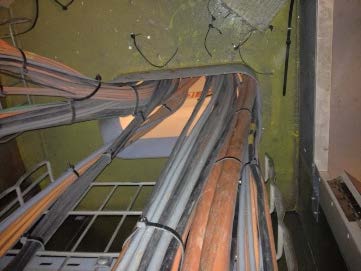Sleep Safe on STI Marine Firestop Pillows
In the event of a fire during construction or repair of the ship, a temporary passive firestop solution is needed to protect the vessel, craftsmen, and crew. Limiting fire spread on a ship is a Valuable, Necessary and Pro-active Safety Measure. ![]()
STI proposes a solution using firestop pillows. The pillows are stuffed around penetrants through open MCT frames, sleeves, scuttles and access ports as a temporary firestop. The pillows are removed and stowed for future re-use once the final firestop is installed before sail-away.
Current practice is to loop temporary utilities and service lines through open fire doors and scuttles, either by running along the deck, or hung overhead from “J” hooks. These temporary utilities restrict the ability of the door or scuttle to be properly secured, if, or when, a fire event occurs. Current Practice also finds cable pulled through open MCT frames and pipes transiting open steel sleeves. These likely remain open and un-sealed during construction to allow additional penetrants to be pulled. Generally, permanent firestop is installed late in the build or repair process. Why not use a temporary and re-useable firestop solution and increase the Fire Safety of the vessel, yard craftsmen, and vessel crew?
Can you identify and supply details as to the types and dimensional sizes of the temporary utilities?
- Electrical power cables
- Communication cables
- Welding Leads
- Compressed Air
- Water
- Ventilation
- Heat / cool
- The size and availability of bulkhead / deck real estate for an “access port” in way of the fire door or scuttle
- Approx. number of MCT frames, sleeves, scuttles, etc that are open and not-fire-stopped until just before ship sails
- Would this port also be available in an emergency to insert an AFFF nozzle / fire nozzle ?
The Primary benefit is achieving a higher level of Safety and Fire Protection during construction and repair. 
- Open penetrations in structural fire zone divisions are hazards to both the vessel and the crew.
- Fire doors and scuttles that are in-operable due to obstructions of temporary utilities are a hazard
- Areas of bulkheads and decks where N-30 insulation has been removed for hot work are a hazard
The ROI to the Owner and the Yard is in minimizing the spread of fire through open penetrations in structural fire zone divisions. This is Passive Fire Protection. It will not Extinguish the fire but will allow active suppressants to be contained within an established fire boundary and not allow the fire to spread through open penetrations.
Help STI identify penetrations that are open and hazardous to the vessel and crew. Your candid comments will be studied, and solutions will be proposed using currently off the shelf firestops that have previously been tested to the 2010 IMO FTP Code for penetrations and are approved for use by the U.S. Coast Guard.

Terry Mannion
Director, Marine Industry Relations
410.963.1160
tmannion@stimarine.com





